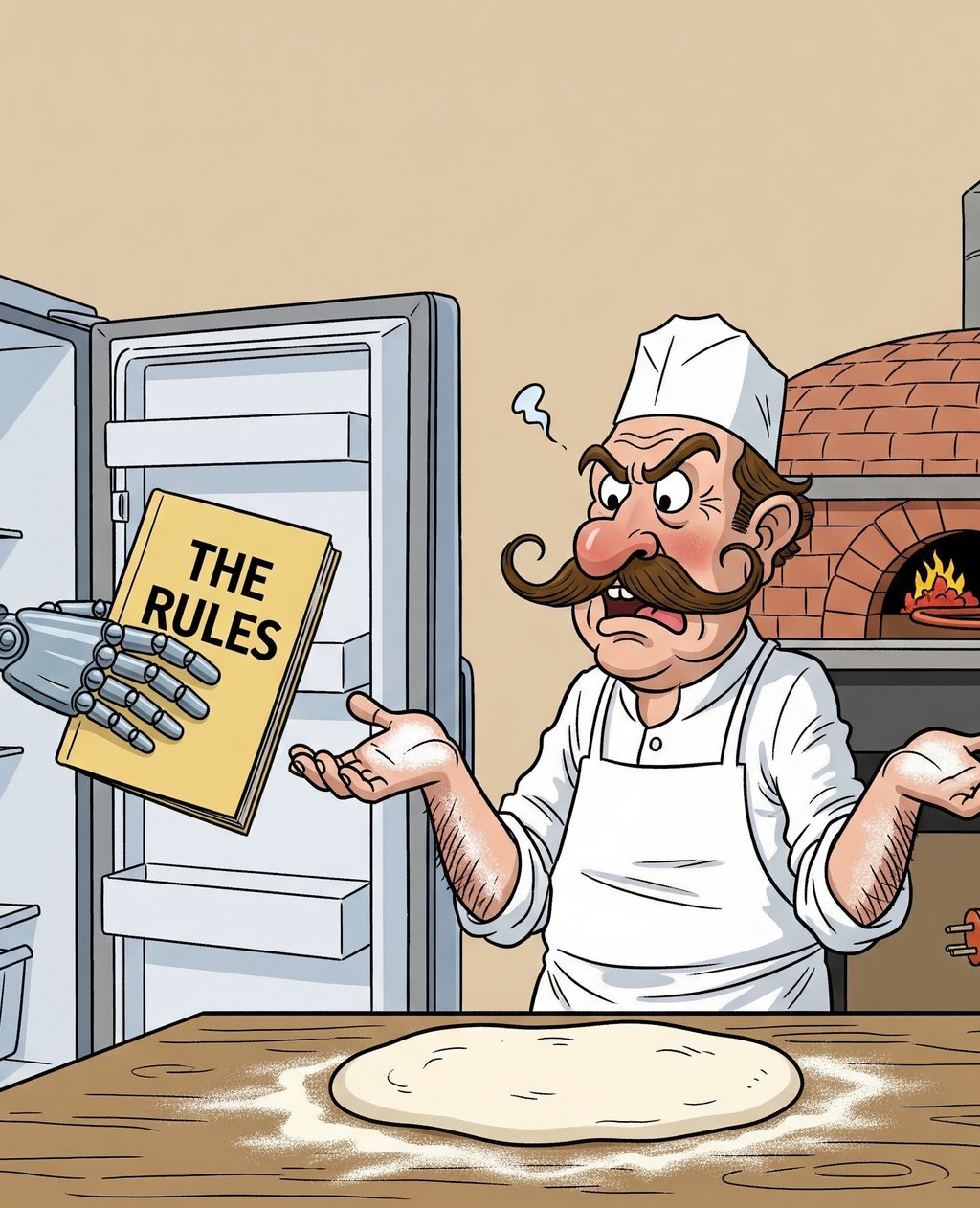Almost Everything You Think You Know About Neapolitan Pizza Is A Deception (And I Have Receipts)
Historical deception from the pizza guys--that want to lord over what "pizza" is
NEAPOLITAN PIZZA VPNINNOVATE PIZZADECEPTION FROM THE PIZZA POLICE
Mark Stens Land
8/6/20254 min read


It’s not even 8 AM here in Albuquerque. The sun is just starting to toast the Sandia Mountains, and I’m already mad.
Not really mad. I’m… activated. Because we need to talk about “pizza.” When Italians, and many others, define pizza--Neapolitan is the standard. Specifically, the sainted, revered, holier-than-thou Neapolitan pizza. According to these folks, Americans aren't allowed to innovate on top of what they've already created.
Now, please don't get me wrong, I respect Italians and their influence on American pizza.
And, I see you. I see you on social media, posting photos of your beautifully blistered, leopard-spotted pies--with your unique airy corniciones ("cor-nee-CHO-knees/ thick fermented crusts). Not the "fish bones" (thrown away commercial yeast typical American crusts)). You’re tagging it #VeraPizzaNapoletana, #Authentic, #Tradition. You’re following “The Rules.” And I’m here today, for your own good, to tell you that the very rulebook you worship is less of an ancient, sacred text and more of a modern branding document written by a committee.
This isn’t for foodies, it’s for eaters (as Dan Pashman would say). And we, the eaters, are being shackled by a false narrative of authenticity!
The culprits are the otherwise well-intentioned folks at the Associazione Verace Pizza Napoletana (AVPN), the self-appointed Pizza Police. In 1984, they laid down the law—the disciplinare—an 11-page document that dictates exactly how a “true” Neapolitan pizza must be made. The right flour, the right tomatoes, the right fermentation time. It’s all very official.
And it’s riddled with historical holes so big you could drive a pizza delivery car through them.
The Great Refrigerator Conspiracy
Let’s start with the big one: fermentation. The Rules state that the dough must rise for 8 to 24 hours. To do this consistently today, every serious pizzaiolo uses a refrigerator to slow the yeast down, a technique called cold fermentation.
Now, let's engage our brains for a moment. The golden age of Neapolitan pizza is the 19th century. Can someone please show me the electrical outlet on the wall of a pizzeria in 1889 Naples? Where were they plugging in their Frigidaire? Did they have a guy running back and forth to a secret alpine glacier with a cooler full of dough balls?
Of course not! As culinary historians will tell you, the closest they had was a cellar, a cantina, which in Naples would be a balmy 13-16°C (about 60°F). That’s not cold-proofing; that’s just… proofing in a slightly less hot room. It’s far more likely, as the work of historian Antonio Mattozzi suggests in Inventing the Pizzeria, that most pizzaiolos were making direct doughs—mixed and baked the very same day. The long, cold ferment is a modern luxury, a brilliant technique for flavor development that was utterly impossible before the invention of, you know, electricity.
The Flour Fallacy and the Tomato Time Machine
The Rules demand "Tipo 00" flour. This stuff is a modern marvel, milled by industrial steel rollers into a powder as fine as confectioner's sugar. Before the late 19th century, all flour was stone-ground. It was coarser, more rustic, and contained bits of bran and germ. The historical pizza crust would have had more in common with today's "Tipo 0" or "Tipo 1" flour. It would have had more character, more texture! My man Harold McGee will tell you in On Food and Cooking, the science just doesn't line up.
Then there’s the tomato. The Pizza Police demand San Marzano D.O.P. tomatoes. A specific tomato from a specific, legally protected region. Sounds impressive, right?
Well, according to David Gentilcore’s definitive history, Pomodoro!, the tomato didn't even become a widespread food in Italy until the 19th century. And the specific San Marzano cultivar we know today? That’s a product of 20th-century agriculture. The whole D.O.P. legal protection system? Established in 1992! Your great-great-great-nonna’s pizzaiolo wasn't checking his tomato's passport; he was using whatever was cheap, local, and available.
So What Am I Saying?
Am I saying your delicious, leopard-spotted, San Marzano-topped pizza is bad? NO! I’m saying it’s MODERN.
And that’s okay!
The problem is the worship of a false history. The AVPN disciplinare is a brilliant piece of modern marketing. It’s what historian Eric Hobsbawm famously called an "invented tradition."¹ It was created in the 1980s to protect the "brand" of Neapolitan pizza from bad imitations around the world. It sets a high standard for quality and consistency, which is a noble goal!
But it’s not history.
The real historical pizzaiolo wasn't a rule-follower; they were a resourceful, brilliant innovator. They used rustic flour because that’s what existed. They used a natural sourdough starter (criscito) because commercial yeast wasn't a thing yet, giving their pies a tang and funk we can only dream of today. They used whatever cheese they could afford, which is why the classic Pizza Marinara has no cheese at all!
My mission here, people, is to free you. Free you from the tyranny of the Pizza Police and their historically dubious rulebook. The spirit of Naples isn’t in blind adherence to a modern document; it’s in the resourceful, adaptable, and delicious chaos of making something amazing with what you have.
So next time some snob tells you your pizza isn't "authentic" because you used a different kind of tomato, you look them in the eye and you tell them Dan Pashman has receipts. Then, you take a huge bite of your delicious, historically-plausible, non-regulation pizza. Because this isn't for food snobs, it's for eaters.
References:
¹ Hobsbawm, Eric, and Terence Ranger, eds. The Invention of Tradition. Cambridge University Press, 1983. Yeah, (I’m putting a real footnote in a blog post. That’s how serious I am about this.)
New Mexican Pizza, LLC | ©2021-2025. All rights reserved.
My post content


